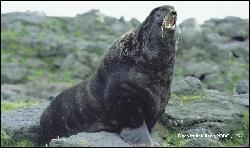
Northern fur seals (Callorhinus ursinus) were first described by Georg Wilhelm Steller in 1742 while shipwrecked on Bering Island in the Commander Island group, Russia (Stejneger, 1936). The largest concentrations of northern fur seals were found on the Pribilof Islands by Gerassim Pribilof in 1786. Northern fur seals belong to the family Otariidae (eared seals).
Fur seals have large, bare flippers which aid in regulating their body temperature, especially on land. Dense fur covers the rest of the body and consists of approximately 46,500 hairs per square centimeter. The fur is a mix of a permanent dense underfur and longer guard hairs which are molted once a year. Their large eyes allow them to see at night. To prevent water from entering while diving, fur seals are able to close their nostrils and their ears which have a narrow, waxy orifice. (Baker et al., 1970). Newborn fur seal pups weigh about 4.5-5.5 kilograms (kg) (Baker et al, 1970), adult females are approximately 30-50 kg, and mature males range from 185-275 kg (Gentry and Kooyman, 1986). From birth males are heavier and longer than females on average. From the tip of the nose to the tip of the tail a large female measures approximately 142 cm while a mature male measures up to approximately 213 cm (Baker et al., 1970). Both sexes are born black with a light underfur, then molt to silver to grey while young, but often appear yellowish brown on shore. Adult male coloration ranges from a reddish brown to black.

